Did you know that by 2050, there will be around 9.8 billion people on Earth? That’s why we urgently need smart solutions to make our food distribution system better. The stress is considerably greater in the dynamic Gulf Cooperation Council (GCC) countries, where economies are booming and populations are rapidly expanding. Technological advancements are empowering local farmers through sophisticated tracking systems and data-backed solutions to keep up with rising consumer demand and guarantee food safety. This blog goes further into the topic and explores how Farm to Plate technology can decisively change and advance the food supply chain globally.
Government Initiatives to Address Food Loss Head-On
Amidst growing worries about food waste and shortages, authorities within the GCC (Gulf Cooperation Council) area have undertaken bold initiatives. They’ve carefully devised extensive, nationwide approaches and taken ambitious initiatives aimed at directly tackling this urgent problem. An inspiring example of this dedication can be observed in Saudi Arabia, which has established an impressive objective of reducing food loss and waste by a noteworthy 50% before the advent of 2030. These endeavors symbolize a a definitive leap towards creating a more enduring nourishment scenario for the whole area. In a bid for a better future, the GCC region hosts innovative startups using technology for sustainability.
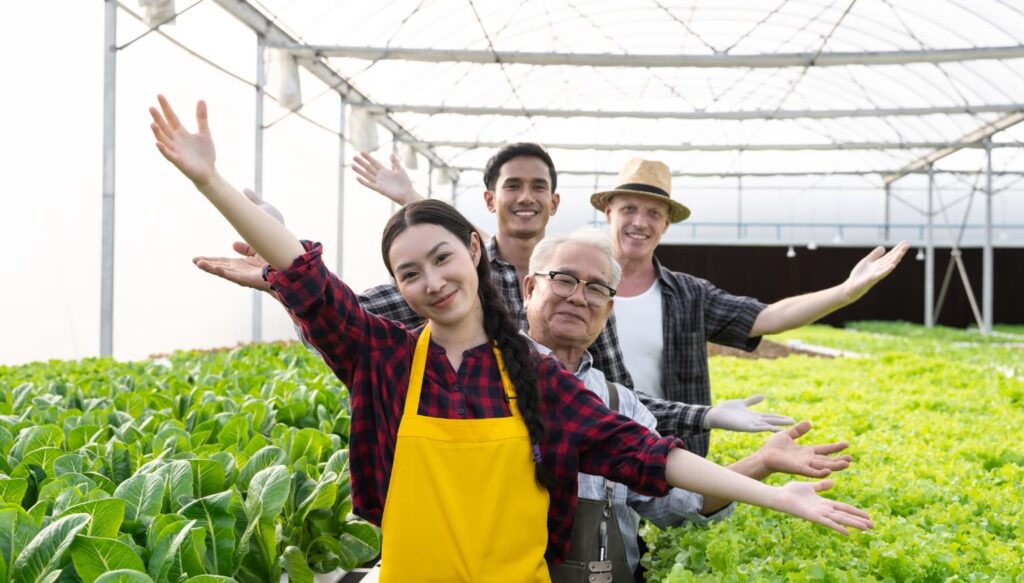
Local producers are vital in the GCC food supply chain, which is often overlooked. These dedicated individuals contribute significantly to the local economy and ensure food stability in the area. However, they face various challenges, from navigating complex regulations to competing with industry giants.
Challenges for Local Producers in the GCC Region
The GCC countries struggle with a unique array of obstacles as they endeavor for sustenance stability. Unyielding weather conditions, a modest farming yield, and a broad dependence on food imports additionally intensify the intricacies of the circumstance. Even the vast cultural diversity in food presents both opportunities and challenges, including supply chain issues and regulatory obstacles for local producers. This section delves deeply into five of the most intricate challenges local producers encounter in this captivating area.
Unforgiving Climate Conditions: Nature’s Wrath

The GCC countries are known for their unrelenting, arid terrains and hot weather. The harsh desert heat and the scarcity of moisture are distinguishing characteristics of this region, making farming a hard undertaking. Local farmers are struggling to develop vegetables and care for animals in an environment where water is scarce. High temperatures are a continual and strong foe.
Low Agricultural Production: The Yield Predicament
One of the striking realities that characterizes the GCC region is its relatively humble farming output in contrast to its swiftly expanding populace. The arid landscape and the lack of cultivable soil greatly hinder the area’s ability to produce a sufficient indigenous nourishment provision. Relying so much on imported food puts much pressure on their food system, making it easily disrupted. Local producers face the tough challenge of increasing what they grow at home. As a result, these local producers need the latest farming methods and technology to produce more food while carefully saving resources.
Heavy Dependence on Food Imports: Vulnerability to External Shocks
The above image highlights the dependence of the MENA region upon food import. It is also a fair comparison with respect to the climatic changes in the region.
Despite their economic might, the GCC countries find themselves heavily dependent on nourishment imports to fulfil the dietary requirements of their consumers. This excessive reliance exposes them to worldwide price fluctuations, the delicacy of supply networks, and the unforeseeable impact of external geopolitical elements. Local producers are assigned to reduce this dependence by strengthening domestic manufacturing and broadening their agricultural repertoire.
Cultural Factors: Hospitality and Diversity
The cultural fabric of the GCC area is delicately intertwined with warmth and superfluity. While such cultural aspects enhance their quality of living, they simultaneously pose complex obstacles for indigenous manufacturers. Hospitality, a treasured virtue, frequently requires luxury, resulting in lavish banquets and culinary spectacles.
Water Scarcity: Liquid Gold
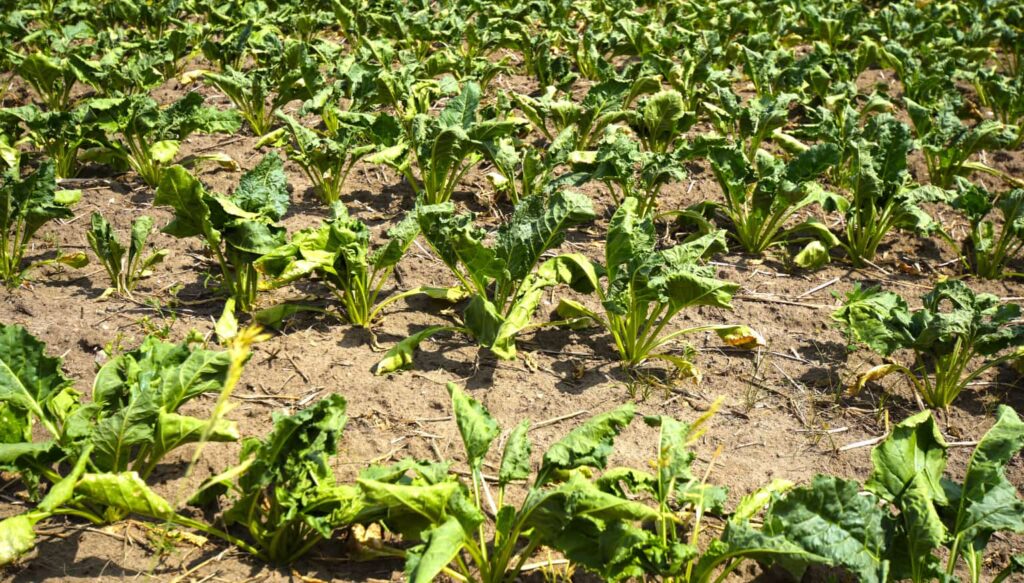
Water achieves an almost legendary status in the GCC area. The rarity of this priceless asset magnifies the complex obstacles local producers encounter. Farming takes up a noteworthy portion of the restricted freshwater resources accessible, escalating the rivalry among diverse sectors for this precious liquid.
| Major Challenges | Their Impact on GCC region |
| Poor – harvest food losses | Estimated 30 to 40% of food produced is lost due to post-harvest losses. |
| Food Insecurity | Over 24.7 million people in the GCC region face food insecurity. |
| Water Scarcity | The GCC region is one of the most water-stressed areas globally. |
| Food Waste | More than 1 billion tons of food are wasted annually. |
The Farm to Plate Approach
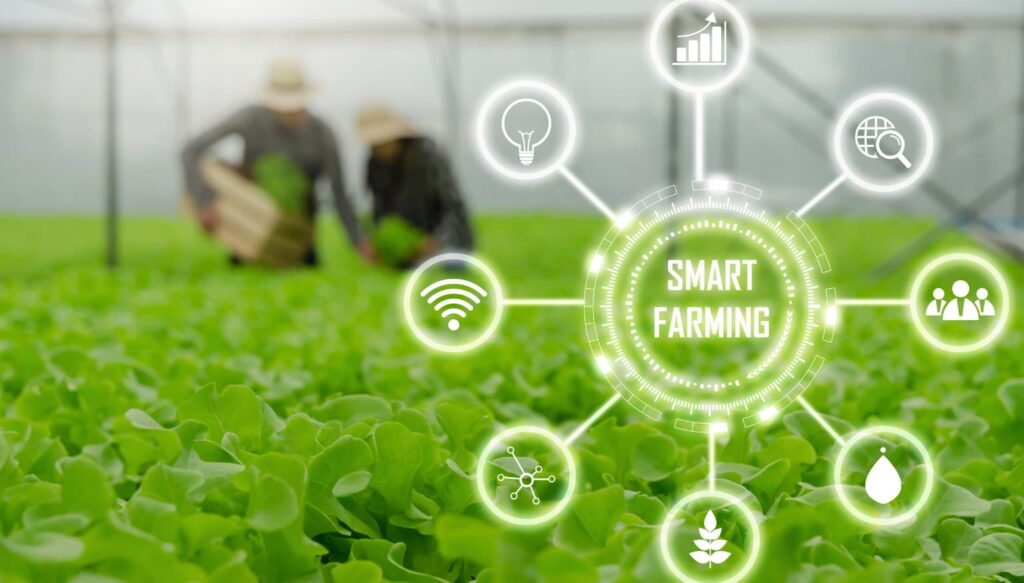
How F2P’s Cutting-edge Technologies Help in Connecting Producers and Consumers?
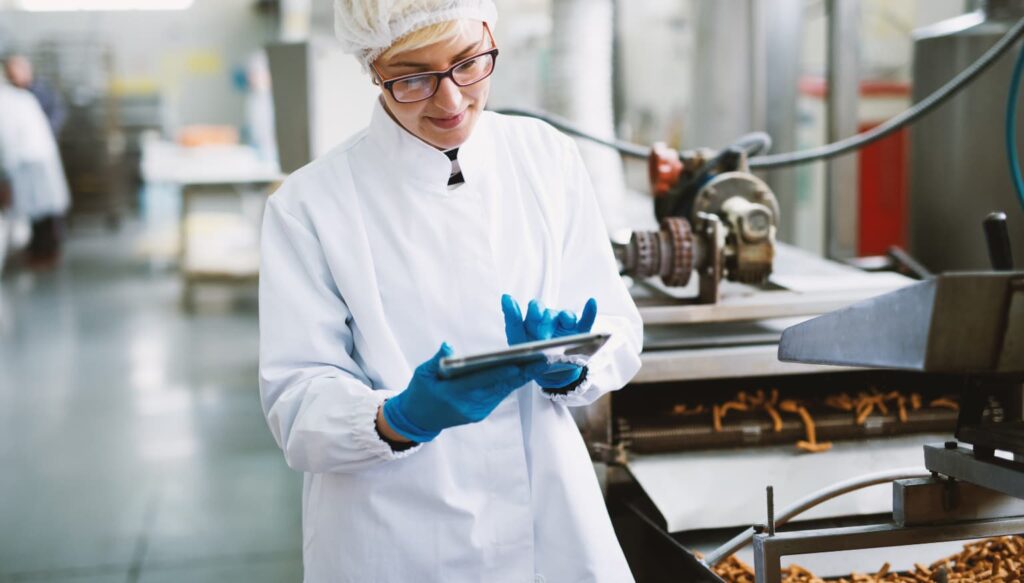
In the food supply chain, F2P plays a pivotal role with its tech-driven solutions that include blockchain to enhance digital traceability solutions.
Not only that, F2P uses various new technologies like Smart Labeling, IoT, AI and many more, to bring change to the entire food distribution system. Their new methods are built around blockchain, which is central to this transformation. Blockchain technology helps gather accurate information, track products quickly, and share data easily.
Flawless Assimilation through IoT
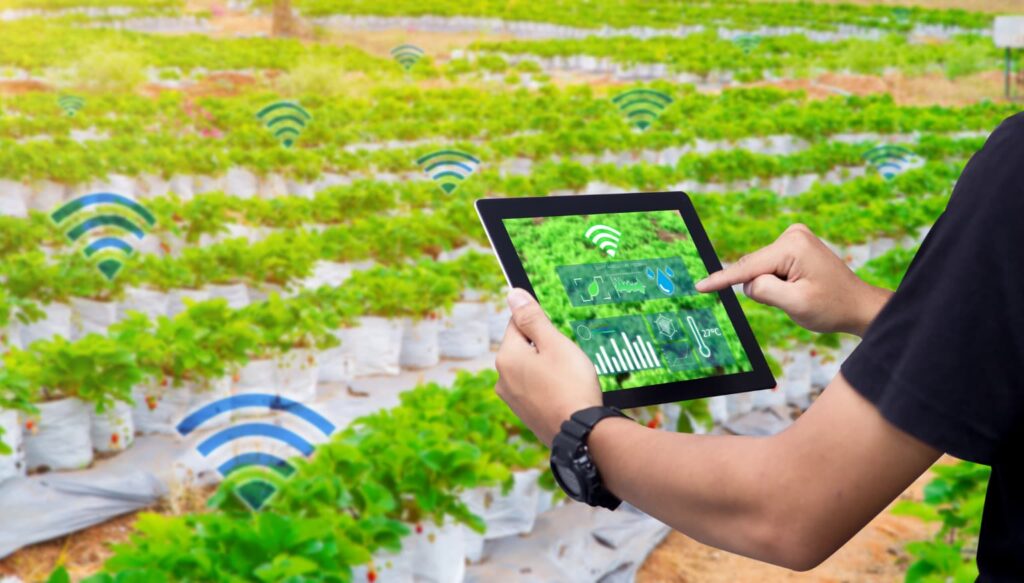
In perfect harmony with blockchain technology, the concept of F2P wholeheartedly embraces the Internet of Things (IoT) as a pivotal instrument for instantaneous visibility. Amidst the formidable ecological terrain of the GCC region, Internet of Things (IoT) sensors utilized by F2P diligently observe and identify irregularities across the entire supply chain, thereby diminishing food wastage and augmenting the safety of products.
Defenders of Excellence: F2P’s Dedication to Nutritional Security
F2P prioritizes preserving food safety and enhancing quality as the fundamental pillars of its mission. Utilizing revolutionary sustenance-detecting methodologies such as hyperspectral imaging and image analysis, F2P guarantees unintrusive, non-destructive evaluations of comestible commodities. These innovations transform food distribution into a transparent supply chain, effectively addressing food scarcity challenges.
Sustainable Agriculture: The Profound Influence of F2P Beyond the Culinary Realm
Beyond the supply chain, the F2P’s actions toward sustainable development have sparked a radical transformation in the agricultural sector. These technological advances are also creating a more stable and secure future for the MENA food supply chain. F2P increases agricultural output while decreasing its ecological effect by using methods like genetic manipulation to improve the quality of seeds and using natural measures to preserve crops.
Empowerment of Small-Scale Landowners: F2P’s All-Encompassing Perspective

The arrival of F2P heralds a new era where efficiency, along with better technology in food traceability and stakeholder empowerment, reigns supreme, with a distinctive emphasis on the noble cause of supporting smallholder farmers. These frequently disregarded champions of agriculture have the potential to reap substantial rewards from F2P’s groundbreaking advancements, encountering amplified revenue, diminished food wastage, and gaining access to the wisdom and resources essential for them to flourish. Furthermore, these digital traceability solutions are revolutionizing the MENA food supply chain, providing unprecedented transparency and efficiency.
Advantages for Local Manufacturers: Succeeding in the Information Age
| Benefits of Technology for Regional Producers | IoT for Real-Time Tracking | Thorough Testing for Food Safety | Monitoring Food Quality and Safety | Blockchain for Transparent Supply Chain and Transactions |
| Increased market entry | IoT ensures real-time monitoring of perishable goods | Utilizes technology for comprehensive food testing | Food-sensing devices track food quality at every supply chain stage | Blockchain records food transactions securely and transparently |
| Competitive pricing | Enhances supply chain visibility and auditability | Ensures food is healthy and up to quality standards | Sensors detect factors like temperature, humidity, and bacterial growth | Prevents food fraud |
| Reduced dependence on intermediaries | Mitigates risks of food fraud and poisoning | Includes physical testing and sensor-based methods | Enhances overall food safety measures | Verifies the origin and authenticity of food products |
Here are some concrete applications of these technologies that are helping to make food supply safer and more traceable:
Real World Implementations By Companies

Some real-world examples of how local producers that have embraced digital transformation have succeeded are provided below.
- Internet of Things (IoT) sensors are used in Walmart’s Food Traceability Initiative to monitor the distribution of food items. This aids Walmart in swiftly locating tainted items and pulling them from shelves.
- IBM Food Trust is a blockchain-based system that monitors the supply chain of edible goods from farm to table. This ensures that the food people buy is both genuine and safe to eat.
- Using food-sensing technology in food traceability, the Open Food Network ensures the health and safety of people in underdeveloped nations. This aids in ensuring that consumers in these nations have access to healthy and wholesome food options.
- A community of Indian farmers utilized WhatsApp to stay in touch and discuss market pricing for their crops. The result was a higher price for their harvest.
- Software on a coffee farmer’s mobile device in Kenya allowed him to monitor the journey of his beans from the farm to the roaster. In this way, he knew he was paying a reasonable price for his coffee.
- A community of Filipino fishermen has turned to Facebook to connect with buyers. This allowed them to save money often paid to intermediaries.
Advantages for Consumers: Safer Food
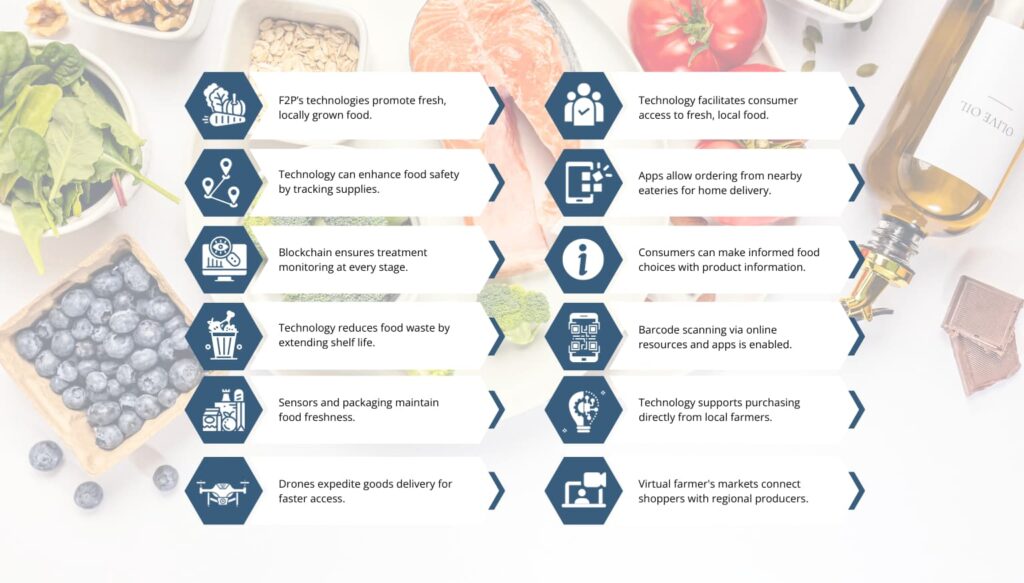
Here are the advantages for consumers, focusing on more hygienic eating conditions:
- F2P’s technologies promote fresh, locally grown food.
- Technology can enhance food safety by tracking supplies.
- Blockchain ensures treatment monitoring at every stage.
- Technology reduces food waste by extending shelf life.
- Sensors and packaging maintain food freshness.
- Drones expedite goods delivery for faster access.
- Technology facilitates consumer access to fresh, local food.
- Apps allow ordering from nearby eateries for home delivery.
- Consumers can make informed food choices with product information. Barcode scanning via online resources and apps is enabled.
- Technology supports purchasing directly from local farmers.
- Virtual farmer’s markets connect shoppers with regional producers.
Impact of Farm to Plate’s Innovative Approach on the Environment
By wholeheartedly adopting the Farm to Plate approach, we usher in a greener future.
- Reduced carbon footprint through shorter food transportation – With real – time monitoring and traceability technology, Farm to plate is able to provide optimized transportation routes. This in turn makes journey shorter, more efficient and reduces carbon footprint
- Preservation of Local Ecosystems and Biodiversity: F2P promotes sustainable agricultural practices, including precision monitoring of soil quality and weather conditions. This helps in reducing the adverse impact due to traditional farming methods.
- Decreased Reliance on Fossil Fuels for Long-Distance Food Transport: With the optimized transportation routes into the picture, F2P naturally decreases the reliance upon fossil fuels for long distance food transport. Additionally, F2P emphasizes a localized supply chain, which also helps in reducing fuel consumption.
- Lower Emissions of Greenhouse Gases like CO2 and Methane: By improving transport efficiency and reducing food wastage through real time monitoring, Farm to Plate contributes to lowered emissions of greenhouse gases like CO2 and Methane.
- Promotion of Sustainable Farming Practices: Precision agriculture helps the local producers to keep a better check at their soil quality, moisture level and other factors. This enables the farmers to make informed decisions.
- Preservation of Natural Resources, Including Water and Soil: Through its data-driven approach, Farm to Plate aids in preserving natural resources by promoting sustainable water and soil management. Farmers receive data on soil health and water usage, allowing them to optimize their resource management.
- Mitigation of Habitat Destruction Associated with Large-Scale Agriculture: Farm to Plate encourages sustainable and localized food production which helps in mitigating habitat destruction for large scale farming or infrastructure.
- Support for Regenerative Agriculture Methods: Farm to Plate encourages regenerative agriculture practices by providing farmers with insights into improving soil quality and overall sustainability. These methods contribute to healthier ecosystems and reduced environmental impact.
- Increased Use of Renewable Energy Sources in Local Food Production: Farm to Plate encourages the use of renewable energy sources as they are easily monitored, cost effective and are not harmful to the environment.
- Reduced Need for Chemical Preservatives and Additives in Food Products: By reducing food waste through accurate monitoring and enhancing food quality through accurate data provided to local producers for their lands, it helps in reduction of need of chemical preservatives. It not only makes the food healthier but also helps in avoiding food borne diseases
Frequently Asked Questions:

What difficulties do GCC-based local producers face?
Tough environment, limited output, high imports, cultural issues, and water shortage.
To what extent is technology assisting with solutions to these problems?
Tools including sensors, drones, AI, blockchain, and cloud-based software.
What is “Farm to Plate” (F2P) and how does it use technology to change the GCC food supply chain?
Facilitates communication between suppliers and buyers, monitors the flow of food from farm to fork, and supplies useful information and resources.
How does blockchain technology improve the efficiency of the food supply chain?
Enhanced openness, traceability, efficiency, and economy.
What difficulties do you anticipate when using blockchain technology in the food supply chain?
Low prices, uniformity, and reliability.
How may blockchain technology evolve in the context of the food supply chain? Increasing adoption, clarity, traceability, and productivity are all positive signs.
Conclusion
We have reached the cusp of positive change as we wrap up our investigation into the evolving environment of the GCC food supply chain. F2P’s commitment to enhancing the world for present and future generations is not a one-time activity but rather an ongoing one. However, as we’ve seen, it’s not simple to reach this sustainable future.
Local farmers in the GCC area confront major hurdles due to the region’s harsh environment and heavy reliance on food imports. With the innovative approach taken by F2P, various technologies like sensors, drones, artificial intelligence, and blockchain technology are all being utilized to address these issues head on. F2P’s aims are perfectly consistent with this concept, and our shared commitment to improving the world is our paramount motivator. So, contact us now and avail your customized Farm to Plate solution today!
Tanya A Mishra, Technical Content Writer & Marketer at farmtoplate.io (specialising in MENA Tech Landscape). She has been working towards crafting insightful content on topics like Blockchain, Agritech, AI and many more.
